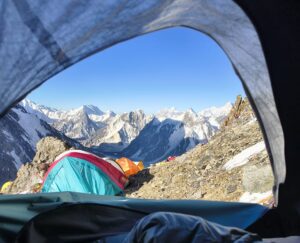This is neither an endorsement nor a condemnation, but instead a statement of near-comprehensive fact: In the old days, mountaineering took place among hardened men using basic gear.
Stoic tolerance of considerable suffering was ethical manna for the likes of a long-lived generation of alpinists like Andreas Hinterstoisser, Marcel Remy, and Chris Bonington.
Journalists and enthusiasts spoke of high mountain ascents in grave, formal tones. Tension was high, danger was ever-present, and consequences were serious.
If that sounds enticing, you’re in for a treat with He Who Dares: The Last Blue Mountain, starring Tony Streather.
Streather is cut from the old cloth and so is this 1971 film. Famous for becoming the first person to climb more than one mountain 7,620 meters (25,000 feet) or higher, Streather was also a distinguished military man.

Streather in uniform. Photo: Screenshot
From the opening frames, you can count on the tone of this one. The high mountain will entertain no flippancy or nonsense, cadet. Suit up and get in the rank and file.
Right away, the narrator recites Streather’s curriculum vitae, debriefing one high-altitude climb thus:
“He led an Oxford University expedition to climb a mountain called Haramosh. He barely escaped with his life…The three other climbers concerned are now all dead.”
What follows is a re-enactment of that ill-fated Karakoram expedition.
After watching just a few minutes, the historical contrast compelled me to continue. It’s easy to forget that mountaineering hasn’t always existed as a maximally engineered, formulaic activity carried out by masters of the trade with functionally limitless resources.
In Streather’s day, the whole enterprise was far more touch-and-go. In many ways, the world explored by The Last Blue Mountain registers as an alien one. Unless you’ve taken on 7,000m peaks with a straight-shaft ice ax, no radio, and no Gore-Tex, you have not been in these climbers’ boots.

Rae Culbert, actor’s portrayal. Photo: Screenshot
But the story the film tells is far from basic. Instead, the trip report (presumably transmitted by Streather) is highly detailed. For instance, after getting caught in a big avalanche, “[expedition member John] Emery’s hip had slipped out of joint. When [Bernard] Jillot tried to straighten his leg, he screamed in pain.”
Also watch that passage to note a classic portrayal of hard-man mountaineer grit: the “scream” is comical.
Settle in for a grueling ride. The team’s self-rescue attempt spanned multiple days and ongoing disasters, and the film chronicles the events faithfully. It seems clear enough that the film’s goal is to give its viewer some corporeal sensation of the surreal exhaustion the group experienced.
Case in point (and spoiler alert): Jillot dies around 21 minutes in. Emory staggers back to camp.
“The consequences of Jillot’s death were too appalling for him to grasp immediately. He was now beyond logical thought or further physical effort,” the narrator states as the actor portraying Emory tumbles into a tent, hyperventilates for a few seconds, and collapses.

“Too appalling to grasp immediately.” Photo: Screenshot
Expect no shortage of such operatic, full-value drama. (Similarly, relish the bullet-hard writing).
But for all the film’s merits, its 1970s movie magic doesn’t always hold up. In the screenshot below, the two men re-enacting an ice climbing fall and self-arrest are very obviously just rolling around on the ground.

The “magic” of cinema. Photo: Screenshot
Still, for my money, it adds to the entertainment value, if anything. Shabby anachronisms like low-rent camera tricks can feel refreshingly human against our current reality of 5K, CGI, and artificial intelligence.

Title screen. Photo: screenshot
And on top of that, a solid mountain survival epic checks out no matter when it’s told. There’s a reason we keep going back to the mountains and coming back with stories — and it’s much older than Tony Streather and 1970s cameras.






